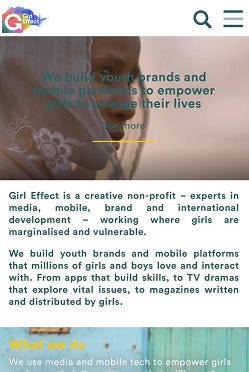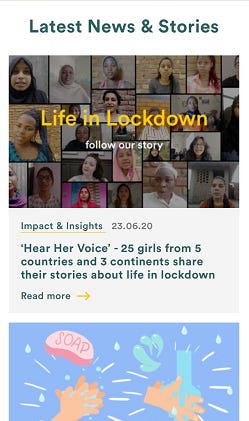In my early days of entrepreneurship, I would cherish getting on the dais and enlightening the world about Indian digital marketing. I stopped after I realized that the events were BS and exchanging cards won’t pay my bills. Anyways the common question during so-called industry interactions was - “No one reads or views my content.” The question now has pivoted to “No one pays for my content.”
Similarly in online fundraising, the common question is, “Why are people not donating?” The question needs to reverse. Why should people give and why should even people trust your nonprofit. Let’s park the excuse that you are doing great work for society. People will trust someone they know, recommended, and have been out there communicating about the impact and work.
Communicating or storytelling is a big role player in online fundraising.
The challenge: it requires continuous investment and more so a long term faith. The majority of brands have failed in content marketing because they have a campaign mindset and lack patience. Nothing wrong in it. Just that next time you quote a Redbull content marketing example please do a bit of research on their history and intent with content.
I recently shared about the Content to Commerce play with the examples of EJI and Children International.
Today I am going to share with you my learnings on how five child nonprofits are using storytelling on their website. Elevation has a list of 200 best nonprofit websites. I selected five for my study with no order in mind.
Invisible Children
Founded in 2004, Invisible Children initially focussed to increase awareness of the activities of the Lord's Resistance Army (LRA) in Central Africa, and its leader, Joseph Kony. Specifically, the group seeks to put an end to the practices of the LRA, which include abductions and abuse of children and forcing them to serve as soldiers. Invisible Children also operates as a charitable organization, soliciting donations, and selling merchandise to raise money for its cause.
With a mobile-first approach, the nonprofit organization’s first look clarifies the “Why” and a simplified call to action for making a donation. As you scroll down the website explains the challenges, the way they work, and the communities that have joined to end cycles of violence and reunite former children, soldiers, with their families.

The blog plays a strong role to carry forward communication. While the organization is creating content around gender inclusivity, community building, etc it is also sharing content around organization updates such as internship engagement and hiring opportunities. In addition to this Crisis Tracker is a content category that focusses on the LRA activities and how the group remains a persistent threat to African communities.

Pencils of Promise
Founded in 2008, Pencils of Promise, also known as PoP is a non-profit organization that builds schools and increases educational opportunities in the developing world.
The nonprofit organization has focussed on the donation lingo from having the first category “Give Monthly” to the hero image on the home page asking for “Education Response Fund” for building the road beyond COVID-19. The rest of the webpage focusses on the progress and the solutions.

The super active blog is unfortunately hidden in the categories. The nonprofit has chosen not to showcase on the webpage where it is talking about the impact. I believe at some point the nonprofit should look at it. Content is categorized around transparency talks, PoP Culture, Notes from the field, etc.

Most nonprofits and brands shy away from talking about the culture or simply put the work experience stories. People want to know the faces, and the work struggles behind the logo. So having stories related to organization culture opens up new content streams.
Girl Effect
Girl Effect is an independent creative non-profit organization, launched in September 2015 with the goal of ending poverty globally. Its work is based on its belief that when given the opportunity, girls are able to lift their countries out of poverty.
The home page makes the “Why” quite clear: “We build youth brands and mobile platforms to empower girls to change their lives.”

The rest of the home page has focussed on sharing news and stories. Stories related to impact, girl-led insights, opinion, news to be read and the list is endless.

Videos have been a strong component of storytelling. The latest one being the lockdown story video about 25 girls from 5 countries - “Hear Her Voice.”
Girls on the Run
Girls on the Run is a non-profit program that works to encourage the development of self-respect and healthy lifestyles in pre-teen girls through dynamic, interactive lessons as well as through running games, all of which culminates in a celebratory 5k run.
The homepage definitely focusses on the “Why” of the nonprofit but I believe the header bar can be simplified. Too many things to consume over a 5” screen.

The nonprofit has focussed on itself, then the cause and the impact. And right at the bottom, you find the section that focusses on storytelling via the blog.
Would you focus on your organization or on the work? Times have changed. People want to know the impact, the stories that you are creating rather than the history of your nonprofit. Even if you are a well-established and legacy organization.
From motivation tips on running to summer activities to teaching kids about the value of the improvement to helping kids learn family values, the blog has just covered every piece of content. But can the way of storytelling be improved? Obviously. You can’t have a DIY article without pictures or videos. No one is going to just read and understand.

KABOOM!
Darell Hammond and Dawn Hutchison founded the company KABOOM! in 1996. They were inspired to start KABOOM! after reading a story in The Washington Post about two local children who suffocated while playing in an abandoned car because they had nowhere else to play.

The website hero image and the text makes the “Why” clear. Besides the nonprofit isn’t asking for donations but asking the viewer to learn about the work. KABOOM! believes in work doing the talking. This is why “Our Work” is their first category and “About” the last category.
Click on it and you get to know how the organization is working to achieve playspace equity - the ability for every kid to have access to incredible places to play. The nonprofit also informs how it is helping communities, driving innovation in playspace design and access.
With COVID-19 being the center stage, the nonprofit has created an extensive guide on how to reopen and promote safe usage of playgrounds. This is important at a time when no age group is immune to the deadly virus.
The category “Impact” has been subdivided into Stories, Research, and Publications. Stories section is the blog that is telling powerful stories of KABOOM transforming communities across the country.

Research and Publications are a repository of reports, case studies, and toolkits that the nonprofit produces or co-produces.
Can other nonprofit organizations follow the path of KABOOM!’s storytelling? Only if they have faith and patience in the art of storytelling. It isn’t easy but it helps people to understand the work the nonprofit is doing and thereby gives confidence to online donation. However, this is just one of the pieces of online fundraising but an important one.



